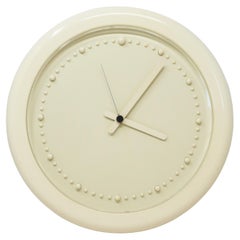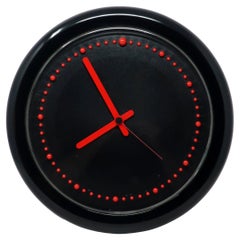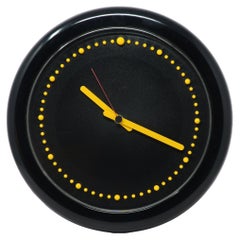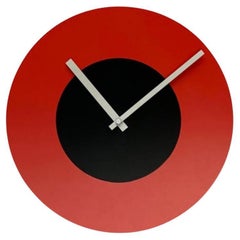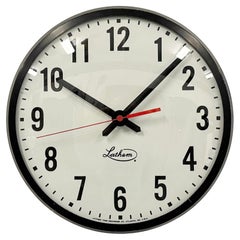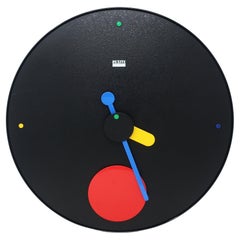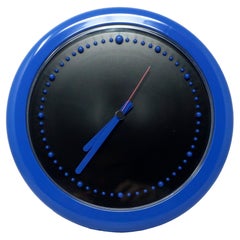Rexite Clocks
to
3
3
3
3
3
Height
to
Width
to
3
3
3
7
71
50
42
38
Creator: Rexite
1980s Postmodern White Rexite Zero 980 Wall Clock
By Rexite, Barbieri e Marianelli
Located in Brooklyn, NY
Designed by Raul Barbieri and Giorgio Marianelli for Rexite in 1981, this Zero 980 wall clock has a striking white on white colorway. White plastic case, white hands, and raised whit...
Category
Late 20th Century Post-Modern Rexite Clocks
Materials
Plastic
1980s Postmodern Black and Red Rexite Zero 980 Wall Clock
By Rexite, Barbieri e Marianelli
Located in Brooklyn, NY
Designed by Raul Barbieri and Giorgio Marianelli for Rexite in 1981, this Zero 980 wall clock has a striking black and red combination. Black plastic case, REd hands, and raised red ...
Category
Late 20th Century Post-Modern Rexite Clocks
Materials
Plastic
1980s Postmodern Black and Yellow Rexite Zero 980 Wall Clock
By Rexite, Raul Barbieri and Giorgio Marianelli
Located in Brooklyn, NY
Designed by Raul Barbieri and Giorgio Marianelli for Rexite in 1981, this Zero 980 wall clock has a striking yellow and black color combination. Black plastic case, yellow hands, and...
Category
Late 20th Century Post-Modern Rexite Clocks
Materials
Plastic
Related Items
Postmodern Wall Clock, 1980s
Located in Hamburg, DE
Postmodern Wall Clock, 1980s, in Very Good conditions. Designed 1980 to 1989.
Additional information:
Materials: Metal, Wood
Color: Black
Styles: Memphis, Postmodern
Item Type: Vint...
Category
20th Century Post-Modern Rexite Clocks
Materials
Metal
Vintage Black School Wall Clock from Lathem, 1980s
Located in Kojetice, CZ
This wall clock was produced by Lathem Time Recorder Co. Atlanta, Georgia in United states during the 1980s. It features a black metal frame, a metal dial and a convex clear glass co...
Category
Late 20th Century American Industrial Rexite Clocks
Materials
Iron
Swatch Wall Clock Maxi 1980s
By Swatch
Located in Čelinac, BA
Swatch wall clock maxi 1980s
Category
1980s Swiss Mid-Century Modern Vintage Rexite Clocks
Materials
Plastic
Postmodern Pyramid Desk or Table Clock by Makiko Taniguchi, Japan, 1980s
By Memphis Milano
Located in Vienna, AT
A beautiful post-modern black and red triangle desk / table / mantel clock from the 1980s. Designed by Makiko Taniguchi, Japan. Made of metal and plastic...
Category
1980s Post-Modern Vintage Rexite Clocks
Materials
Metal
1980's Postmodern Advertising Wall Clock by RADO of Switzerland
Located in San Diego, CA
Rare Rado wall clock advertizing for store owners double tone silver and black beautiful condition the face is made of polished acrylic and aluminium back , battery operated clock ci...
Category
20th Century Swiss Post-Modern Rexite Clocks
Materials
Aluminum
Vintage Black Kappa Maritime Wall Clock, 1980s
By Kappa
Located in Kojetice, CZ
Vintage Kappa navy slave clock designed during the 1970s and produced till 1990s. These clocks were used on large Korean tankers and cargo ships. It features a black metal body, a me...
Category
Late 20th Century South Korean Industrial Rexite Clocks
Materials
Chrome, Iron
1980s Postmodern Memphis Era Wall Clock by Howard Miller
By Howard Miller
Located in San Diego, CA
Great design and rare piece circa 1980s glass face with a brass ring frame, and a black plastic frame with a withe plastic accent edge line, Classic design from the Memphis era nice ...
Category
20th Century American Post-Modern Rexite Clocks
Materials
Aluminum
$380 Sale Price
20% Off
H 2 in W 11 in D 11 in
Midcentury Wall Clock Weimar, Germany 1980s
By Weimar Electronic
Located in Praha, CZ
Made in Germany
on one battery
functional
sun pattern, beautiful accessory
Category
1980s German Mid-Century Modern Vintage Rexite Clocks
Materials
Metal
Postmodern Wall Clock, 1980s
Located in Čelinac, BA
This postmodern clock is part of a unique series of24 hand made wall and table clocks bz the young designer ERNEST hofman from 1980. Each clock is unique.
Category
1980s Serbian Post-Modern Vintage Rexite Clocks
Materials
Wood
Glass Pendulum Clock Takashi Kato Postmodern, 1980s Japanese Design
By Memphis Milano, Nathalie du Pasquier
Located in Shibuya-ku, Tokyo
Glass pendulum clock by Sessa. It can be used as both standing on the table and hanging on the wall. Takashi Kato designed a lot of clocks in the 1980s-19...
Category
1990s Japanese Post-Modern Rexite Clocks
Materials
Glass, Plastic
$250 Sale Price / item
50% Off
H 13.78 in W 6.3 in D 2.76 in
Postmodern Italian Mantel Clock by Michael Graves for Alessi, 1980s
By Michael Graves (b.1934), Alessi
Located in Hamburg, DE
Rare table clock of the Italian manufacturer Alessi after a design by Michael Graves from 1986. A special and rare collector's object of Postmoderne.
The coat Clock is a miniature a...
Category
1980s Italian Post-Modern Vintage Rexite Clocks
Materials
Metal
$5,880
H 9.85 in W 6.38 in D 3.67 in
1980's Postmodern Salem Cigarettes Advertising Wall Plastic Decorative Clock
Located in San Diego, CA
A very collectible classic wall plastic clock with Neon Graphics, by Salem cigarretes nice original condition clock has Japanese battery movement , no cracks on the case just some l...
Category
20th Century American Post-Modern Rexite Clocks
Materials
Plastic
$275
H 20 in W 14 in D 2.5 in
Previously Available Items
Contrattempo Pendulum Wall Clock by Barbieri and Marianelli for Rexite
By Barbieri e Marianelli, Rexite
Located in Brooklyn, NY
Designed by Raul Barbieri and Giorgio Marianelli for Rexite,the Contrattempo pendulum wall clock is postmodern design at its best. A black textured face, blue and yellow hands, and a...
Category
Late 20th Century Post-Modern Rexite Clocks
Materials
Metal
1980s Postmodern Black and Blue Rexite Zero 980 Wall Clock
By Rexite, Raul Barbieri and Giorgio Marianelli
Located in Brooklyn, NY
Designed by Raul Barbieri and Giorgio Marianelli for Rexite in 1981, this Zero 980 wall clock has a striking black and blue combination. Blue plastic case, blue hands, and raised blu...
Category
Late 20th Century Post-Modern Rexite Clocks
Materials
Plastic
1980s Postmodern White and Black Rexite Zero 980 Wall Clock
By Barbieri e Marianelli, Rexite
Located in Brooklyn, NY
Designed by Raul Barbieri and Giorgio Marianelli for Rexite in 1981, this Zero 980 wall clock has a striking white and black color combination. Black plastic case, black hands, and r...
Category
Late 20th Century Post-Modern Rexite Clocks
Materials
Plastic
1980s Postmodern White and Black Rexite Zero 980 Wall Clock
By Barbieri e Marianelli, Rexite
Located in Brooklyn, NY
Designed by Raul Barbieri and Giorgio Marianelli for Rexite in 1981, this Zero 980 wall clock has a striking white and black color combination. Black plastic case, black hands, and r...
Category
Late 20th Century Post-Modern Rexite Clocks
Materials
Plastic
1980s Postmodern Red and Black Rexite Zero 980 Wall Clock
By Rexite, Raul Barbieri and Giorgio Marianelli
Located in Brooklyn, NY
Designed by Raul Barbieri and Giorgio Marianelli for Rexite in 1981, this Zero 980 wall clock has a strikingly contrasting red and black color combination. Red plastic case, red hand...
Category
Late 20th Century Post-Modern Rexite Clocks
Materials
Plastic
Rexite clocks for sale on 1stDibs.
Rexite clocks are available for sale on 1stDibs. These distinctive items are frequently made of plastic and are designed with extraordinary care. There are many options to choose from in our collection of Rexite clocks, although black editions of this piece are particularly popular. If you’re looking for additional options, many customers also consider clocks by Nathalie du Pasquier, Canetti, and George Sowden. Prices for Rexite clocks can differ depending upon size, time period and other attributes — on 1stDibs, these items begin at $395 and can go as high as $395, while a piece like these, on average, fetch $395.
